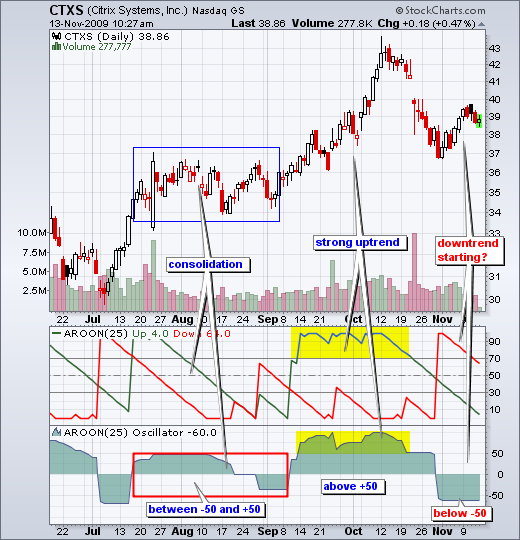|
|
The Aroon Oscillator is simply Aroon(down) subtracted from Aroon(up). It is positive when Aroon(up) is greater than Aroon(down) and negative when Aroon(down) is greater than Aroon(up). The oscillator can be used as a stand alone indicator or in conjunction with Aroon(up) and Aroon(down). As noted in the chart school article, Aroon means “dawn’s early light” in Sanskrit. Tushar Chande, a serial indicator developer, created this indicator to determine the direction and strength of the trend. You can find formula details in the
chart school article.
A strong uptrend is present when Aroon(up) is above 70. Upside momentum dissipates when Aroon(up) declines below 50. Similarly, the bulls have the edge when the Aroon Oscillator is positive. This bullish edge increase as the oscillator becomes more positive. Oscillator readings above +50 signal a strong uptrend.
A strong downtrend is present when Aroon(down) is above 70. Downside momentum dissipates when Aroon(down) declines below 50. Similarly, the bears have the edge when the Aroon Oscillator is negative. This bearish edge increases as the oscillator becomes more negative. Oscillator readings below -50 signal a strong downtrend.

Click this chart for details.
In the example above, Citrix (CTXS) shows Aroon examples of a strong uptrend, a consolidation and the start of a downtrend. First, the Aroon oscillator was between -50 and +50 during the consolidation. Citrix could not establish strong direction as Aroon(up) and Aroon(down) remained close together. Second, a strong uptrend started when Aroon(up) surged above 70 and the Aroon Oscillator moved above +50 (yellow area). Third, Aroon(down) recently surged above 50 and the Aroon Oscillator moved below -50. This move suggest that a downtrend is starting for Citrix. You can also find "Stocks in a new uptrend (Aroon)" signals on the stock scans page.
A strong uptrend is present when Aroon(up) is above 70. Upside momentum dissipates when Aroon(up) declines below 50. Similarly, the bulls have the edge when the Aroon Oscillator is positive. This bullish edge increase as the oscillator becomes more positive. Oscillator readings above +50 signal a strong uptrend.
A strong downtrend is present when Aroon(down) is above 70. Downside momentum dissipates when Aroon(down) declines below 50. Similarly, the bears have the edge when the Aroon Oscillator is negative. This bearish edge increases as the oscillator becomes more negative. Oscillator readings below -50 signal a strong downtrend.

Click this chart for details.
In the example above, Citrix (CTXS) shows Aroon examples of a strong uptrend, a consolidation and the start of a downtrend. First, the Aroon oscillator was between -50 and +50 during the consolidation. Citrix could not establish strong direction as Aroon(up) and Aroon(down) remained close together. Second, a strong uptrend started when Aroon(up) surged above 70 and the Aroon Oscillator moved above +50 (yellow area). Third, Aroon(down) recently surged above 50 and the Aroon Oscillator moved below -50. This move suggest that a downtrend is starting for Citrix. You can also find "Stocks in a new uptrend (Aroon)" signals on the stock scans page.


